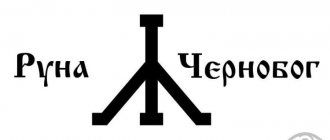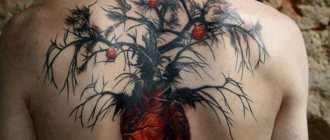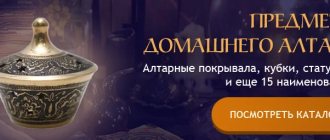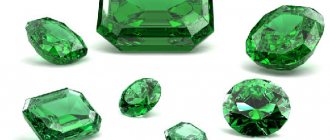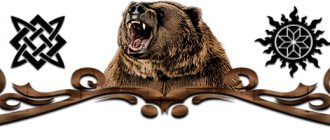The world tree (lat. Arbor mundi) is a mythological archetype, a universal tree that unites all spheres of the universe. As a rule, its branches correspond to the sky, the trunk - to the earthly world, the roots - to the underworld.
In science, there are different views on the universality of this archetype. V.N. Toporov and his followers interpret the World Tree broadly, identifying it with the World Axis in all its variants. With this approach, any image of a tree in culture (including the Tree of Life) is considered as a reference to the World Tree. With the help of this image, according to Toporov, “general binary semantic oppositions that serve to describe the basic parameters of the world are brought together.” A number of major researchers (I.M. Dyakonov, Yu.E. Berezkin, V.V. Napolskikh) oppose such an expansive interpretation and note that among some peoples this archetype does not occur at all.
The meaning of the tree of life amulet
The amulet can be made using any technique.
The Slavic tree of life is a symbol of harmonious development and continuous growth. It personifies the endless development and transformation of the old obsolete into something newer, younger.
The meaning in protective magic goes beyond the simple protection of the gods. This personifies the connection with ancestors, gods and the universe. The amulet with ancestral memory is available for use for babies from birth.
It can be used as a family item: a panel with an image, carvings, clay or metal products, embroidery and application to walls or fabric.
The image of the tree of life is considered a powerful amulet.
As a personal talisman, it can be worn in the form of a pendant, ring, bracelet, earrings or other jewelry.
The “tree of life” amulet has colossal energy similar to the energy of the “ star of Russia”
».
- Helps to find harmony with the inner world;
- promotes the correct intrauterine development of the child when carried by a pregnant woman;
- in case of problems with pregnancy, it helps to conceive and give birth to a healthy baby;
- harmonizes family relationships;
- protects the family from litter, misunderstanding and insults;
- attracts good luck;
- maintains health;
- protects against the evil eye, damage and negative energy.
The Tree of Life amulet is suitable for newborn children.
We are Slavs! Maria Semyonova, 1997
Perun Svarozhich
Perun is the Slavic God of Thunder, the God of thunder and lightning. They imagined him as a middle-aged, angry husband with a red, swirling beard. Let us immediately note that a red beard is an indispensable feature of the God of Thunder among a variety of peoples. In particular, the Scandinavians, neighbors and relatives of the Slavs in the Indo-European family of peoples, considered their Thunderer (Thor) to be red-bearded. Needless to say, the fiery golden color of the Thunder God’s beard is by no means accidental!
The hair of the Thunder God was likened to a thundercloud. Scandinavian legends note that an angry Thor "shaked his hair." It is not definitely said what color Thor’s hair was, but the Slavic Perun’s hair is really like a thundercloud - black and silver. It is not for nothing that the statue of Perun, which once stood in Kyiv, is described in the chronicle as follows: “The head is silver, the mustache is gold.” The Slavs saw their God rushing among the clouds on horseback or in a chariot drawn by winged stallions, white and black. By the way, the magpie was one of the birds dedicated to Perun, precisely because of its black and white coloring.
The name Perun is very ancient. Translated into modern language, it means “He who hits hard”, “Striking”. Some scholars see a connection between the name of the Thunder God and words such as “first” and “right”. As for the “first”, Perun was indeed the most important God in the pagan pantheon of Kievan Rus and, probably, the eldest son of Svarog. The similarity of his name with “right” is also not without meaning. As will be described in the chapter “Star Bridge”, Perun was considered by our ancestors to be the founder of the moral law and the very first defender of Truth.
Perun’s chariot rushing desperately thunders across the uneven clouds - that’s where the thunder comes from, that’s why it “rolls” across the heavens. However, there were different opinions on this matter. They also said that thunder and lightning are the echo and reflection of the blows with which Perun rewards the heavenly Serpent, who seeks to rob the Gods and people again - to steal the Sun, cattle, earthly and heavenly waters (this eternal battle will be discussed in more detail in the chapters “Serpent Hair” and "Star Bridge") And in distant antiquity it was believed that thunder was actually a “cry of love” at the celebration of the wedding of Heaven and Earth: it is known how well everything grows after a thunderstorm...
According to some sources, Perun’s lightning was of two kinds: lilac-blue, “dead,” striking to death, and gold, “living,” creative, awakening earthly fertility and new life.
It has long been noticed how clean the air is and how easy it is to breathe when the thunderstorm has passed. The pagan Slavs found an explanation for this too. The whole point, they said, is that evil spirits scatter in fear before Perun’s wrath, hide in holes and for a long time do not dare to stick their heads out!
Perun, who is largely “responsible” for fertility, has a special relationship with bread. A legend has been preserved about how a certain unreasonable woman went to the field to work on the holiday of Perun (July 20), which according to custom was impossible to do. The angry Perun initially restrained his anger. But when the child, left at the boundary, soiled his diapers and the mother wiped him with a bunch of ears of grain (according to another version, a piece of baked bread was desecrated) - trouble broke out: a whirlwind arose and carried away the entire harvest into the cloud. Some of it still managed to be threshed back, but the “hundred-eared” bread (a hundred ears on each stalk) was never born again...
Thunder sign. Images from the bottom of the spinning wheel and the mother of the hut. 19th century
The legend about the origin of pearls is also connected with heavenly thunder. The Slavs believed that it originates from the reflection of lightning captured in the eyes of a pearl mollusk at the moment when it fearfully slams its shell shut at the sight of a thunderstorm...
Perun's weapons were initially stones, later - stone axes and finally - a golden ax: The gods “progressed” together with people. Since ancient times, the ax - the weapon of the Thunderer - has been attributed miraculous power. An ax was used to hit the bench on which someone had died: it was believed that by doing so Death would be “cut down” and expelled. The ax was thrown crosswise over the cattle so that they would not get sick and would reproduce well. With an ax they drew the Solar Cross over the sick person, calling on two brothers-Gods for help at once. And symbolic images of the Sun and Thunder were often engraved on the blades of axes. Such an ax, planted in a doorframe, was an insurmountable obstacle to evil spirits seeking to penetrate human habitation. There are truly countless customs and beliefs associated with the axe. Even the well-known “chicken god”, a pebble with a hole in the middle, which caring owners are now trying to hang in the chicken coop, is nothing more than a memory of an ancient stone ax, one of the symbols of the pagan God of the Storm...
Another symbol of Perun is the so-called thunder sign, similar to a wheel with six spokes. Scientists believe that ancient people used the shape of a snowflake here, because Perun’s sanctuaries were built as close as possible to the clouds and the Sky - on the tops of mountains (at least in the most elevated places), where snow appears first. This sign can still be seen on the old huts. It was cut both for beauty and for purely “practical” reasons - as a lightning rod...
When the Slavs had princes and fighting squads, Perun began to be considered the patron saint of warriors. Therefore, some researchers now write that Perun is an exclusively “army-princely” God, not at all popular among the common people. It is unlikely that this was really the case! After all, a thunderstorm is not only a heavenly battle, it is also necessary for a plowman waiting for the harvest. And Perun’s main feat was precisely that he returned fertility to the Earth, returned the Sun and rain.
Priestly knife and bronze sharecutter
An animal was dedicated to Perun - a wild aurochs, a huge, mighty forest bull. Unfortunately, in the wild, the last aurochs was killed back in 1627, and only the domesticated descendants of aurochs—domestic bulls and cows—survived to this day. Turs differed from them in size: a bull reached almost two meters at the withers - and also in color: bulls were black, with a white “belt” - a stripe along the ridge, and “turits” cows were bay (dark red with black tails). The tour was much more aggressive than the angriest domestic bull. Predatory animals were powerless against him, and among people, hunting aurochs was considered a feat. People believed that Perun, walking around the world, willingly takes the form of a forest bull. And on July 20 (we remember that this is the holiday of Perun), the tours allegedly ran out of the forest themselves and allowed themselves to be stabbed for a sacred feast. Later, when people angered the Gods with something, the tours stopped appearing, and sacrificial bulls were specially fattened in the villages. This tradition was strictly observed in many places even in the last century. Only now a pagan feast was held near the church, and a Christian priest blessed it.
Tour. (Bos primigenius)
Perun has his own tree - oak, and he also has a favorite flower, which in Bulgaria is still called “perunika”. It has six lilac-blue petals (a sign of thunder!), covered with golden hairs (lightning!). It blooms in the spring, when the first thunderstorms thunder. This flower is very beautiful, and we call it iris - in Greek “rainbow”, because different varieties of irises come in very different colors. The scientific, Latin name of perunica is Iris Germanica.
1. Sanctuary of Perun near Novgorod. Reconstruction.
2. Krasnogorsk sanctuary.
The reconstruction of
the Sanctuary of Perun took place in the open air. They were shaped like a flower; in those sanctuaries that have been excavated by archaeologists, there are usually eight “petals”, but in ancient times, according to scientists, there were six. The “petals” were pits in which unquenchable sacred fires burned. A sculptural image of God was placed in the middle. Now the word “idol” has a somewhat contemptuous connotation in our speech (remember, for example, “filthy idol”), sometimes we even hear that the ancient Slavs “believed in idols.” But this is the same as saying that Christians “believe in icons.” An altar was placed in front of the image of God, usually in the form of a stone ring. Offerings were placed there, sacrificial blood was shed: most often animal blood, and if the people were threatened with serious misfortune, then human blood. Life has always been considered a sacred gift of the Gods: human sacrifice was an extraordinary, exceptional act. And we must also take into account that, according to scientists, the person designated as a sacrifice did not necessarily burst into bitter tears and try to escape. Sacrifices were also voluntary: a person went to the Gods to tell them about the needs of his people, ask for help, ward off trouble - as we would put it now, “closed the embrasure with himself”...
The fiery ascent of Elijah the Prophet. From an icon of the 16th century. Here Ilya the Prophet surprisingly resembles the thunderer Perun...
After the adoption of Christianity, Perun was by no means forgotten. Only a few customs that have survived to this day are described here; in fact there are a great many of them. True, the Orthodox Church forbade praying to the former Gods, and the sanctuaries were destroyed with the same unnecessary cruelty with which churches were destroyed almost a thousand years later by militant atheists. However, scientists say that Christianity not only “smashed” paganism, but also tried to peacefully coexist with it, subordinating it to its hierarchy of values. It is no coincidence that particularly acute conflicts rarely occurred, because over time a kind of symbiosis arose. In particular, having been baptized, yesterday's pagans continued to honor the old Gods, only under new names. So Perun “transferred” many of his qualities to Ilya the Prophet, one of the most revered Christian saints. Another “heir” of the Thunder God is Saint George, the serpent fighter who so proudly rides on a white horse across the coat of arms of Moscow. It is too dangerous to interrupt traditions. Smart people understood this at all times, including a thousand years ago.
DIY tree of life
The painting is a talisman that protects the house and all family members from external and internal negativity.
The amulet has great energy if it is made with your own hands or as a gift to loved ones.
The material can be:
- tree;
- metal (preferably silver);
- stone;
- tree;
- natural threads;
- beads or beads;
- clay;
- wire.
tattoo - amulet
The method of making a home or personal talisman depends on skill and can be made using any technique.
The easiest way to make an amulet will depend on the artist, you can embroider a picture or on the clothes of relatives, draw with paints on a wooden base, paint windows using the stained glass painting technique, crochet in the form of a toy, knit a pattern for a children's blanket, blanket or jacket, carve on wood .
To create a pendant pendant from wire and beads you will need:
- thin wire for weaving roots and branches,
- beads or beads,
- base ring (you can weave it yourself from wire or buy a ready-made one).
You can use a do-it-yourself amulet made of wire and beads as a pendant or keychain.
Manufacturing progress:
- cut thin wire into pieces of approximately 15-20 cm in multiples of 3;
- winding it around the ring to form roots,
- connect all the wires into a single trunk,
- from the trunk make branches into branches, which you further divide into smaller ones in random order, leaving the ends loose,
- you can put beads or beads on the “branches”,
- weave each branch into a common circle.
- The finished amulet can be used as a pendant around the neck, above the crib, or in a child’s room.
The semantic load of the image of the world tree
The tree of life is firmly rooted in different cultures; it symbolizes the structure of the universe. The roots are the Navi world (the underworld), the trunk is the waking world (the real world), and the crown symbolizes the government - the world of the gods. Using the world tree growing on the Alatyr stone, located on the island of Buyan, many heroes of folklore travel through the worlds in search of their truth. After all, a tree is an axis that connects all worlds into one.
Another meaning is the connection of times: the past is the roots, the present is the trunk, the future is the crown.
The image of the world tree is also a symbol of the clan, ancestral memory, where the roots are our parents (and all past generations), the trunk is ourselves, and the branches and leaves represent our descendants (children, grandchildren, great-grandchildren).
It is believed that the more powerful the family connection (roots), the stronger the crown (children and grandchildren), it is not for nothing that the history of the family is studied when compiling a family tree.
World tree in Slavic mythology
The tree of life in Slavic mythology is a model of world structure.
In Slavic mythology, the world tree personifies the universe, Iriy (paradise) is located in the crowns, where the light gods live, the roots are the world of Navi - the patrimony of Chernobog
,
Mary
and other gods of darkness.
The trunk is a symbol of earthly life, a habitat for people and various animals and birds.
Often found in rituals where it symbolizes the arrival of the new year, the trunk is a prototype of the road of life, and the tree is also a powerful symbol personifying fertility, procreation, and wisdom.
In ancient times, all temples and temples were built around a powerful tree, the crown of which rose above the roof, symbolizing the firmament.
The Slavic tree of life is the center of the universe connecting all worlds. The semantic load is the infinity of development and rebirth, the connection between light and darkness, people and gods, the living and the dead.
There is a description of the tradition of building a house using the image of the universe. The young tree was planted in the center of the future housing and remained inside until construction was completed. After completion, the structure was dug up and transplanted to another location.
World tree in different cultures
The tree of life is often found in the myths of different cultures. It always symbolizes the world order and the strong connection of both worlds (present, underground and heavenly) and generations.
- Scandinavian culture. Yggdrasil, as a symbol of wisdom and secret knowledge, taught Odin many secrets and gave runic writing.
- In Egypt, the sacred acacia is a conductor between the world of the living and the dead.
- In Persian culture, it personifies fertility and is considered the source of all living things, as well as life itself.
- In the teachings of alchemists, the tree personifies immortality.
- For the Celts, the sacred oak symbolizes the center of the entire universe. Provides communication between all worlds.
Who is this talisman suitable for?
The Tree of Life amulet is perhaps the most universal one you can find. This image is found in many religions. Moreover, not only in the old pagan ones, but also in the relatively young Christianity. It is precisely this widespread distribution that allows the amulet to be used by people of almost any religion, without violating either the laws of conscience or the foundations of the accepted faith.
The amulet is suitable for people of any age and gender.
The Sacred World Tree symbolizes the simultaneous connection with all generations - present, past and future. Therefore, a person of any age, including even the smallest children, can wear such a talisman. In terms of gender, there are also no restrictions, because the Tree of Life contains harmonious energy that is equally well compatible with both the male and female sex.
The symbol can be used as a personal amulet, but will also become an excellent family amulet, improving the atmosphere of the house and protecting its inhabitants.
Image on objects and amulets
Embroidery or knitting pattern for a talisman for the whole family.
The tree can be supplemented with other patterns and symbols. The image of a tree can be found on all household items, clothing, bedding, personal and household talismans.
A knitted blanket with a tree pattern will be an excellent amulet for a newborn baby.
You can use any knitting pattern you like or draw it yourself.
Crochet pattern.
This crocheted tree of life will be a wonderful home decor item.
How he is portrayed
There are many ways to depict an ancient symbol. Any person, having heard the phrase Tree of Life, will imagine a thick trunk of an ordinary tree with a set of roots and a large green crown. However, this is not the only way of presentation. There are visualizations that do not resemble trees, in particular, the image of a vertical line with three branches pointing upward.
You can find the Tree of Eternal Life in the form of a woman, with her hands pointing to the sky. The meaning of such an image is a request for the protection of the Gods and faith in their support and power. Slavic peoples created amulets in the form of patterns and embroidery paintings, for example, life for them means a flowering tree, and a knot means prolongation of life.
It is believed that if a tree is well developed, blooms and is more than a hundred years old, then the number of people and their state of life is higher than normal and is improving every day.
